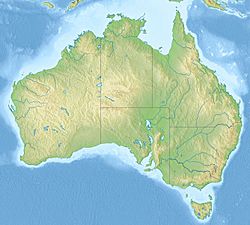Otway Basin facts for kids
Quick facts for kids Otway Basin |
|
|---|---|
| Coordinates | 38°S 141°E / 38°S 141°E |
| Region | Southeastern South Australia and Southwestern Victoria |
| Country | Australia |
| State(s) | South Australia and Victoria |
| Characteristics | |
| On/Offshore | Both |
| Part of | Australian Southern Rift System |
| Area | 150,000 km2 |
| Geology | |
| Basin type | rift basin |
| Age | Jurassic – late Cretaceous |
| Stratigraphy | Crayfish, Eumeralla, Shipwreck, Sherbrook, Wangerrip, Nirranda, Heytesbury, & Whalers Bluff Groups |
| Faults | Tartwaup-Mussel & Avoca-Sorell Fault Systems |
| Field(s) | Minerva, Casino, Geographe, & Thylacine Gas Fields |
The Otway Basin is a huge area of rock layers found along the southern coast of Australia. It covers about 150,000 square kilometers. That's like a really big state! This basin stretches from southeastern South Australia to southwestern Victoria. Most of it (80%) is actually offshore, under the ocean, in water that can be from 50 to 3,000 meters deep.
The Otway Basin is a type of "rift basin." This means it formed when huge pieces of the Earth's crust pulled apart. It's part of a series of basins along what's called the Australian Southern Rift System. The basin started forming a very long time ago, from the late Jurassic period to the late Cretaceous period. This happened in stages as the supercontinent Gondwana broke up and Antarctica moved away from Australia. Today, the Otway Basin holds a lot of natural gas, which is taken out and used for energy.
Contents
How the Earth's Plates Shaped It
The Otway Basin formed as part of a big crack system in southern Australia. This happened from the late Jurassic period (around 160 million years ago) to more recent times. It was all part of the huge supercontinent Gondwana breaking apart. During this time, Antarctica slowly started to pull away from Australia.
The basin is in a special spot where the land was pulling apart in different ways. This area had lots of "transtensional faulting." This means there were cracks in the Earth's crust that pulled and twisted at the same time. This twisting and pulling created the basin's complex shape and how its layers were laid down. The land stretched and sank many times. Eventually, new ocean floor started forming between Australia and Antarctica.
Deep Areas Where Sediments Collected
The Otway Basin has five main "depocenters." These are like big, deep bowls where lots of sand, mud, and other materials (called sediments) collected over millions of years. These deep areas are called the Inner Otway Basin, Torquay Sub-basin, Morum Sub-basin, Nelson Sub-basin, and Hunter Sub-basin. They formed because of two major periods when the Earth's crust pulled apart.
The first big pulling-apart phase happened in the late Jurassic period. This created the east-west trending deep areas in the onshore part of the basin, forming the Inner Otway Basin. Later, in the late Cretaceous period, the pulling changed direction. It went from north-south to northeast-southwest. This new pulling created the Torquay, Morum, Nelson, and Hunter Sub-basins. These are found more in the middle and offshore parts of the basin. After each pulling phase, the basin sometimes got squeezed. This caused older structures to twist or push up.
The Basin's Changing Layers Over Time
The Otway Basin is filled with eight different groups of rock layers. These layers tell us the story of how the basin formed and changed over millions of years.
Early Rifting: The Beginning of the Basin
The basin started to form when Australia and Antarctica began pulling apart in the late Jurassic period. As the Earth's crust stretched, cracks formed. These cracks filled up with about 5,000 meters of sediments. These sediments came from land and ancient rivers and lakes. This first group of layers is called the Crayfish Group.
Later, around the Aptian age, the basin slowly sank over a wide area. This allowed about 4,000 meters of river and lake sediments to be laid down. These layers form the Eumeralla Formation.
Mid-Cretaceous: Squeezing and Lifting
The first big pulling-apart phase stopped around the Albian age. At this time, the basin was squeezed and lifted up. This caused some erosion across the whole basin. Geologists call this a major "unconformity," which means there's a gap in the rock record where layers were removed or not deposited.
Late Cretaceous: Pulling Apart Again
After about 6.5 million years, the pulling apart started again in the Turonian age. This time, the Earth's crust stretched in a new direction: northeast-southwest. This created large and deep areas in the middle and offshore parts of the basin. About 1,300 meters of river and delta sediments were deposited during this phase. These layers make up the Shipwreck Group.
Then, a major "marine transgression" happened in the Campanian age. This means the sea level rose a lot and covered more of the land. This led to about 5,000 meters of delta and marine sediments being laid down. These layers form the Sherbrook Group.
Late Maastrichtian: Continents Move Apart
In the late Cretaceous period, the pulling apart of the continents turned into "seafloor spreading." This is when new ocean floor is created as plates move away from each other. This marked the start of "passive margin" conditions in the Otway Basin. A passive margin is a quiet edge of a continent where there isn't much plate activity.
As Australia and Antarctica continued to move apart, the basin slowly sank even more. This created more space for sediments to collect. From the late Maastrichtian period until today, layers of marine sediments and carbonate rocks have been deposited. These layers form the Wangerrip, Nirranda, Heytesbury, and Whalers Bluff Groups. These groups are separated by other "unconformities," which show times when the basin was squeezed or lifted up again.


